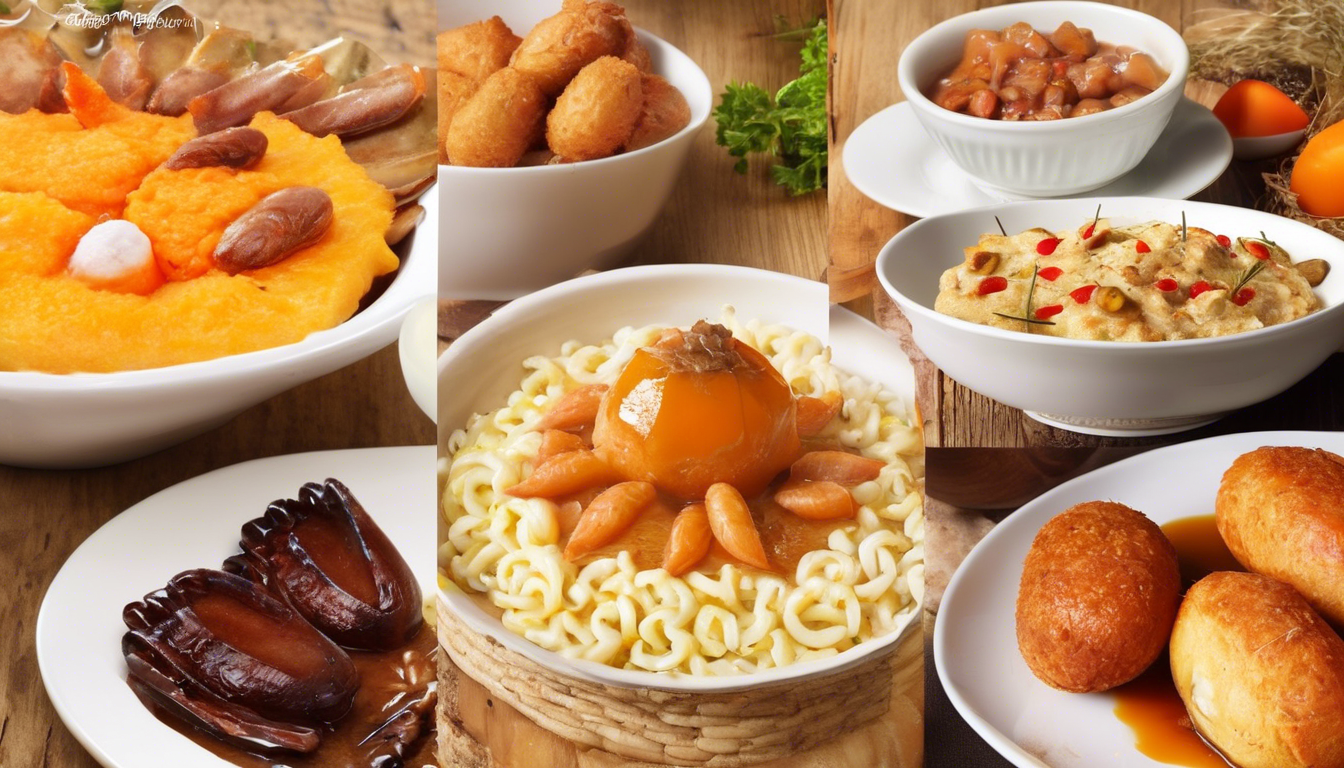Top 10 Must-Try Traditional Dutch Dishes For Food Lovers

Top 10 Must-Try Traditional Dutch Dishes for Food Lovers
If you’re a food lover, exploring traditional Dutch cuisine is a journey you won’t want to miss. The Netherlands boasts a variety of hearty and flavorful dishes that reflect its rich cultural heritage. Here’s a list of the top ten must-try traditional Dutch dishes that will tantalize your taste buds and give you a true taste of the Netherlands.
1. Stroopwafels
Stroopwafels are sweet treats that consist of two thin waffles filled with a rich syrup made from caramel. Originating from the city of Gouda, these delectable snacks are best when served warm. You can enjoy them by placing a stroopwafel over a hot cup of tea or coffee, allowing the steam to melt the syrup. This gooey confection is perfect for a cozy afternoon treat.
2. Bitterballen
This popular Dutch snack is a must-try for any food lover. Bitterballen are deep-fried balls filled with a savory mixture of beef or veal ragout. Often served with mustard for dipping, they’re a staple in Dutch pubs and at parties. Crispy on the outside and soft on the inside, these bite-sized delights are perfect for sharing with friends.
3. Haring
Haring, or raw herring, is a traditional Dutch delicacy that many enjoy. This fish is typically marinated in a light brine and often served with onions and pickles. You can eat it by holding the fish by the tail and taking a bite or as part of a sandwich known as “haringbroodje.” It’s an acquired taste but definitely worth trying for its unique flavor and texture.
4. Patat
Patat, or Dutch fries, are famous for their crispy exterior and soft interior. Unique to the Netherlands, these fries are often served with a variety of tasty sauces. Popular choices include mayonnaise, satay sauce, and ketchup. They’re ideal for satisfying your snack cravings, whether enjoyed at a street vendor or a casual eatery.
5. Oliebollen
These delightful Dutch doughnuts are especially popular during New Year’s celebrations. Oliebollen are deep-fried balls of dough, often filled with raisins or currants, and dusted with powdered sugar. They are warm, sweet, and fluffy—perfect for ringing in the new year or simply indulging your sweet tooth!
6. Dutch cheese
The Netherlands is renowned for its cheese, particularly Gouda and Edam. These cheeses have rich flavors and smooth textures that are perfect for snacking or adding to various dishes. You can enjoy them on a charcuterie board or as part of a traditional Dutch cheese platter known as “kaasplank.” Don’t forget to sample some aged Gouda for an even more intense flavor experience.
7. Erwtensoep
Erwtensoep is a thick pea soup that is a staple during the colder months. Made primarily from green split peas, vegetables, and pork, this hearty dish is perfect for warming you up. It’s typically served with rye bread and sometimes has a side of smoked sausage. A bowl of erwtensoep will easily satisfy your hunger and give you a taste of traditional Dutch comfort food.
8. Poffertjes
Poffertjes are fluffy, mini pancakes that are a popular treat at fairs and markets. They are typically served with a sprinkle of powdered sugar and a pat of butter. Light and airy, poffertjes are a delightful indulgence that you can enjoy as a snack while exploring the quaint streets of Dutch towns.
9. Kapsalon
A trendy dish that originated in Rotterdam, kapsalon is a fast-food favorite made of layers of fries topped with shawarma, melted cheese, and a fresh salad. It’s finished off with garlic sauce and sambal for a spicy kick. This indulgent creation has become immensely popular among locals and tourists alike, offering a guilty pleasure that hits the spot.
10. Rijsttafel
Rijsttafel means “rice table,” and it’s an elaborate dining experience that reflects the Dutch colonial history in Indonesia. It consists of an array of small dishes served with rice, allowing you to sample various flavors and textures. This vibrant feast showcases the fusion of cultures and offers an opportunity to experience a unique aspect of Dutch cuisine.
Sampling these traditional Dutch dishes provides not only a delightful culinary experience but also a glimpse into the culture and history of the Netherlands. So, whether you’re planning a trip or simply curious about Dutch cuisine, make sure to try these ten must-try dishes. Your taste buds will thank you!
Uncovering the Culinary Heritage of the Netherlands
The culinary heritage of the Netherlands is as rich and varied as its picturesque landscapes. For food lovers, exploring this heritage opens up a world of flavors, traditions, and stories that reflect the Dutch spirit. From hearty meals to delightful snacks, traditional Dutch dishes give you a deep and satisfying taste of the culture. Here’s a closer look at some beloved Dutch foods you simply must try.
Stroopwafels
Nothing says Dutch like a stroopwafel. This delicious treat consists of two thin waffles filled with caramel syrup, or “stroop,” making it an irresistible snack. Enjoy it hot, placed over a cup of coffee or tea to soften the caramel, and you’ll experience a true Dutch delight.
Haring
Raw herring is a beloved Dutch delicacy. It’s typically served with onions and pickles, and locals enjoy it by holding it by the tail and taking a bite. The fish is fresh and full of flavor, and it embodies the Netherlands’ maritime culture. If you’re feeling adventurous, this is a must-try dish!
Patat
Dutch fries, known as “patat,” are an essential comfort food. These thick-cut fries are usually served with a variety of toppings and sauces. One of the most popular combinations is patat oorlog, which comes with mayonnaise, satay sauce, and chopped onions. The crispy exterior and fluffy interior make them unforgettable!
Erwtensoep
A thick pea soup known as “erwtensoep” is a favorite winter dish in the Netherlands. Made with split peas, smoked sausage, and vegetables, this hearty soup is often enjoyed with rye bread. It’s perfect for warming you up on a chilly day and is typically served at family gatherings.
Boerenkool
Boerenkool, or kale, is another traditional Dutch dish often enjoyed in winter. The kale is mashed with potatoes, resulting in a comforting and hearty meal, usually accompanied by smoked sausage. This dish reflects the Dutch love for simple, nourishing food.
Speculaas
These spiced biscuits are widely enjoyed in the Netherlands, especially around St. Nicholas Day. Made with a blend of spices such as cinnamon, nutmeg, and cloves, speculaas has a distinctive flavor. Enjoy them with coffee or tea, and you’ll find they capture the essence of Dutch tradition in every bite.
Hutspot
This dish is a comforting mash-up of carrots, onions, and potatoes. Hutspot has a historical significance, traditionally prepared to celebrate the 1574 victory of the Dutch over the Spanish. Served hot and often paired with meat, it’s a staple in many Dutch households.
Poffertjes
Poffertjes are small, fluffy pancakes that are light and airy. Typically topped with powdered sugar, these treats can be found at fairs and markets throughout the Netherlands. Their delightful sweetness and soft texture make them a favorite among both children and adults.
Oliebollen
These Dutch doughnuts are especially popular during the New Year’s celebrations. Typically filled with raisins or apples, oliebollen are deep-fried and dusted with powdered sugar. Eating these delectable treats while welcoming the New Year has become a cherished tradition in Dutch culture.
Rijsttafel
Although originating from Indonesia, the rijsttafel has found a special place in Dutch cuisine due to historical ties. This rice table includes various small dishes, such as meats, vegetables, and sambals. Sharing a rijsttafel meal is a communal and joyful experience, showcasing the richness of flavors in Dutch-Indonesian fusion.
Embarking on this culinary journey through the Netherlands will invigorate your palate and introduce you to local customs. Each dish tells a story of Dutch traditions, ingredients, and flavors that have stood the test of time. Don’t miss the chance to savor these remarkable dishes that celebrate the heart and soul of Dutch cuisine.
The Role of Cheese in Dutch Cuisine
The Netherlands is renowned for its picturesque canals, windmills, and, of course, cheese. As a country rich in culinary traditions, cheese plays a pivotal role in Dutch cuisine. Whether you’re a cheese lover or simply curious about Dutch gastronomy, understanding the significance of cheese in this culture is a journey worth taking.
Cheese has been a staple in the Dutch diet for centuries, deeply entrenched in the country’s agricultural practices. The lush green pastures and favorable climate make it ideal for dairy farming. As a result, the Netherlands produces a wide variety of cheeses, each with its unique flavor and texture. Among the most famous are Gouda, Edam, and Leyden, each representing the regional specialties and history of the Dutch people.
Traditional Varieties
Here are some traditional Dutch cheeses you absolutely must explore:
- Gouda: Perhaps the most famous Dutch cheese, Gouda can range from young and mild to aged and robust. Its creamy texture makes it perfect for melting, while older varieties offer rich, nutty flavors.
- Edam: Recognizable by its red wax coating, Edam is semi-hard with a slightly salty taste. It makes a great addition to cheese boards or served with crusty bread.
- Leerdammer: A unique cheese with a sweet and nutty flavor, Leerdammer is often compared to Emmental due to its holes. It’s fantastic in sandwiches or as a snack.
- Old Amsterdam: This aged Gouda is known for its rich, caramel-like flavor and crumbly texture, making it perfect for cheese lovers seeking something bold.
- Maasdam: Characterized by its large holes, Maasdam is a smooth, slightly sweet cheese that melts beautifully, adding flavor to dishes.
Each of these cheeses has its own story, linked to the region where it is made. You could spend a delightful time discovering the various cheese markets, such as those in Alkmaar and Gouda, where locals and tourists gather to buy and sample the best selections.
Cheese in Everyday Life
In Dutch households, cheese is often part of breakfast or lunch, served simply on bread with toppings. You might find it paired with butter and sliced tomatoes or even accompanied by pickles. It’s not uncommon for families to have their favorite cheese, which they purchase regularly from local vendors.
Moreover, cheese is an essential component of the Dutch “borrel” platter, a selection of snacks typically enjoyed with drinks in social settings. Guests will often find a delightful array of cheeses, meats, olives, and bread laid out for enjoyment.
Culinary Innovation
Besides being enjoyed on its own, cheese is also integral to various traditional dishes. Here are a few examples of how cheese is used creatively:
- Cheese Soufflé: A light and fluffy baked dish, cheese soufflés are a sophisticated yet comforting way to enjoy Dutch cheese.
- Patat Met Kaas: This is a popular snack where fries are topped with gooey cheese and often paired with a delicious sauce.
- Cheese Soup: This creamy soup incorporates a variety of cheeses, creating a warm and savory dish perfect for chilly evenings.
In recent years, the culinary scene has witnessed an explosion of creativity using cheese. Chefs are now experimenting with cheese pairings, using herbs, spices, and even sweet flavor profiles to create innovative dishes that elevate traditional Dutch flavors.
The Global Cheese Community
The appreciation for Dutch cheese extends beyond the country’s borders. Cheese festivals and tasting events attract food enthusiasts from around the globe. As the world becomes more interconnected, Dutch cheeses have gained popularity in international markets, introducing new palates to their distinct flavors. Moreover, the Dutch have a long history of exporting cheese, bringing authentic flavors to cheese lovers everywhere.
When visiting the Netherlands, indulging in the local cheese is mandatory. Whether at a lively market, an artisanal cheese shop, or a cozy café, the experience of tasting fresh Dutch cheese is truly unparalleled. The substantial role that cheese plays in Dutch cuisine reflects the rich agricultural heritage of the country and offers food lovers a flavorful experience that should not be missed.
With its variety of textures, flavors, and uses, cheese is not just an ingredient but is woven into the very fabric of Dutch culture. So, if you find yourself in the Netherlands, make sure to savor the delicious cheeses that have contributed to the country’s culinary identity for centuries.
Exploring Street Food Culture in Dutch Cities
Street food culture in the Netherlands is a vibrant tapestry of flavors, aromas, and experiences that reflect both the country’s rich history and modern culinary trends. From bustling market squares to lively festivals, Dutch cities serve up a thrilling array of street food options that cater to every palate. Whether you are a local or a tourist, indulging in these delightful treats is an essential part of experiencing Dutch life.
One of the most iconic street foods is the stroopwafel. Originating from Gouda, this delightful treat consists of two thin waffles filled with a sweet syrup. You can find vendors serving them fresh, often with the top waffle warmed over a cup of coffee or tea. The sweet, gooey center instantly melts in your mouth, making this a must-try for anyone with a sweet tooth.
Another beloved option is kroket. This deep-fried snack, often filled with meat ragout, is a Dutch classic. You’ll spot kiosks serving up these crispy delights in various flavors, including beef, chicken, and vegetarian options. Typically served with a side of mustard for dipping, kroket is the ultimate comfort food that’s perfect for on-the-go munching.
The frikandel is another popular street food, particularly favored by sports fans munching during events. This skinless minced meat sausage is usually deep-fried and served with a generous drizzle of mayonnaise, ketchup, and curry sauce. Get ready to satisfy your cravings as you bite into the juicy texture and flavorful spices.
Don’t miss out on bitterballen, a Dutch favorite that’s often served in pubs. Similar to kroket, bitterballen are round balls filled with a rich beef or veal ragout. They are best enjoyed hot and paired with a cold beer for a perfect evening snack. When you’re in a busy city like Amsterdam or Rotterdam, you can find plenty of stands offering these delightfully crispy treats.
Moving on to seafood, haring (or raw herring) is a unique delicacy you cannot overlook. Traditionally sold from street carts, it’s served either with onions and pickles or eaten straight from the fish vendor’s hand. This dish is all about freshness, and trying it is a rite of passage for many visitors. Just remember to hold the fish by the tail and take a big bite!
For those who are craving something lighter or vegetarian, patat is the ultimate guilty pleasure. These thick-cut fries are a street food staple and are often accompanied by a multitude of sauces. From mayonnaise to peanut sauce and onions, you can personalize your plate to your liking. They make for a fulfilling snack while exploring the bustling streets.
While exploring Dutch street food culture, you’ll also find an array of vegetarian and vegan options. Many cities now boast a growing number of food stalls and trucks focused on plant-based dishes. From tasty falafel balls to veggie burgers, these options ensure that everyone can indulge in the local flavors.
Street markets in cities like Amsterdam, Rotterdam, and Utrecht are vibrant places where you can discover not only traditional Dutch street foods but also international cuisines. Markets such as Albert Cuyp Market in Amsterdam and Bazar in Rotterdam offer a fusion of flavors, delightful smells, and the excitement of trying something new.
During festivals, street food takes center stage, with food trucks offering everything from Asian fusion tacos to gourmet burgers. These events are perfect opportunities to taste a variety of dishes, socialize with locals, and soak up the lively atmosphere.
The experience of savoring street food in Dutch cities goes beyond just the flavors. It’s about connecting with local culture, meeting new people, and creating memories through food. Whether you’re wandering through markets or attending a festival, there’s a sense of community that comes with each bite.
As you navigate through the unique street food offerings, don’t forget to interact with the vendors. Many are happy to share not just their culinary passion but also stories about their favorite dishes and the history behind them. So, whether you’re a foodie or just someone looking to explore Dutch culture through cuisine, trying street food is an adventure you won’t want to miss.
Seasonal Ingredients and Their Influence on Dutch Cooking
In the Netherlands, the rich heritage of food is closely tied to the seasons. Seasonal ingredients play a crucial role in Dutch cooking, influencing flavor, availability, and culinary practices. By making the most of their seasonal bounty, Dutch chefs create dishes that highlight freshness and regional produce.
Spring heralds the arrival of young greens, asparagus, and fresh herbs. With the melting snow, farmers dig up the first shoots of green asparagus, which are quickly incorporated into many dishes. Paired often with melted butter or hollandaise sauce, this tender vegetable defines Dutch spring cuisine. Other early spring vegetables include:
- Spinach: With its delicate flavor, this leafy green can be found in salads or cooked into traditional dishes like spinazie met ei (spinach with egg).
- Radishes: Crunchy and slightly spicy, radishes add a pop of color and flavor to salads.
- Herbs: Fresh dill, chives, and parsley enhance dishes with their aromatic qualities.
As summer approaches, the fields and gardens of the Netherlands burst with bounty. This is the time for vibrant vegetables and sweet fruits. The flavor profiles become more dynamic, with dishes celebrated for their freshness. Tomatoes, bell peppers, and cucumbers begin to take center stage. Dutch salads become light and refreshing as they embrace these summer flavors. Not to forget the important Noord-Hollandse nieuwe haring (young herring), which is traditionally consumed with chopped onions and pickles.
Summer fruits are a highlight, featuring:
- Strawberries: Dutch strawberries are praised for their sweetness and are often enjoyed fresh or in desserts.
- Cherries: These juicy gems are popular in pies or simply enjoyed as a snack.
- Apples: Summer apples are a delightful addition to salads or can be cooked into compotes.
Autumn brings about a harvest celebration. The cooler temperatures invite hearty root vegetables, starchy tubers, and comforting dishes. Potatoes, carrots, and seasonal squashes start to dominate the markets. Dutch comfort food comes alive during this season, with warming stews like boerenkoolstamppot (mashed potatoes with kale) taking the stage. With the focus on hearty meals, it’s a wonderful time to enjoy
- Pumpkins: Used in soups, stews, and as roasted side dishes, pumpkins add rich flavor.
- Beets: This colorful root can transform salads and become a star ingredient in various dishes.
- Chestnuts: These nuts are not just for desserts; they also add an interesting texture to savory dishes.
Winter in the Netherlands is not just about cold weather but also about warming meals. As the temperature drops, ingredients like cabbage, winter squash, and hearty grains come into play. Traditional dishes are hearty and filling, perfect for cold evenings. This season is known for:
- Red cabbage: Often stewed with apples, this side dish brings a balance of sweetness and acidity.
- Leeks: Used in soups and casseroles, leeks add a mild onion flavor to many winter dishes.
- Kale: A versatile green that can be massaged into salads or cooked into comforting dishes.
Local markets burst with seasonal ingredients throughout the year, connecting communities with their food sources. Chefs often flock to these markets to select the freshest produce, ensuring their dishes embody the essence of Dutch culinary traditions. By embracing seasonal produce, Dutch cooking not only highlights sustainability but also showcases the flavors that each season uniquely offers.
The influence of seasonal ingredients on Dutch cooking cannot be overstated. From hearty winter meals to springtime salads, the diverse landscapes of the Netherlands provide an array of flavors and textures that inspire culinary creativity. As you seek to explore Dutch cuisine, remember that the seasonal approach is about more than just fresh ingredients; it’s a celebration of culture, tradition, and respect for nature’s cycles.
Embracing the seasons means every bite tells a story. Whether you are indulging in the light flavors of spring or the comforting warmth of winter, you are sure to experience the heart and soul of Dutch cooking. So, next time you visit the Netherlands or explore Dutch recipes at home, incorporate seasonal ingredients for an authentic culinary experience.
Conclusion
As you journey through the vibrant culinary landscape of the Netherlands, it’s clear that traditional Dutch dishes offer a delightful blend of flavors, textures, and rich history. The top 10 must-try dishes showcase the country’s culinary heritage, highlighting the importance of regional ingredients and time-honored recipes that have stood the test of time.
Central to Dutch cuisine is cheese, a staple that elevates many meals while also symbolizing the country’s agricultural roots. From the tangy Gouda to the creamy Edam, Dutch cheese not only enhances the taste of various dishes but also serves as a cultural icon worth discovering in its own right.
Exploring the bustling street food culture in cities like Amsterdam and Rotterdam reveals a world of culinary adventure waiting for you to sample. These vibrant markets and food stalls offer everything from crunchy stroopwafels to savory bitterballen, giving you a taste of everyday Dutch life while providing the perfect opportunity to indulge in authentic flavors.
Additionally, the influence of seasonal ingredients in Dutch cooking ensures that every bite is fresh and bursting with flavor. Embracing the rhythm of the seasons, Dutch chefs craft dishes that beautifully reflect nature’s bounty, offering a unique dining experience that changes throughout the year.
By immersing yourself in these traditional dishes and the stories behind them, you not only savor delicious food but also connect with the rich culture and history of the Netherlands. For food lovers, each meal is an invitation to discover the heart and soul of Dutch cuisine, making every bite an exceptional experience.






